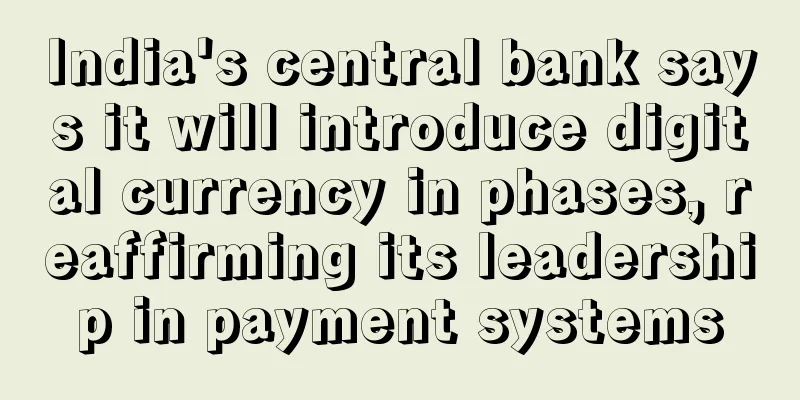India's central bank says it will introduce digital currency in phases, reaffirming its leadership in payment systems

|
“Perhaps the era of digital currency (CBDC) has arrived.” On July 22, local time, when introducing the recent plans of the Reserve Bank of India, its deputy governor T. Rabi Sankar said, “The Reserve Bank of India is considering the phased introduction of a centrally-backed digital currency to protect people from the price fluctuations of cryptocurrencies.” The Reserve Bank of India said that the introduction of digital currency may bring significant benefits, such as reducing dependence on cash, reducing transaction costs and settlement risks. "The introduction of CBDC may bring more efficient, more credible, more standardized and more legal currency-based payment options. It will undoubtedly also cause related risks, but its benefits need to be more carefully evaluated. The Reserve Bank of India will work hard to follow up in this regard and take the necessary steps to reaffirm India's leadership in the payment system." “For countries to enjoy the dividends of global settlement, it is important for both countries in the currency transaction to have CBDC,” Sankar explained. “From India’s own perspective, India is a world leader in digital payment innovation, with retail and wholesale customers, and real-time transaction costs that may be the lowest in the world. It is difficult to find another payment system like UPI that allows one-rupee transactions.” The results of a Reserve Bank survey released in April 2021 showed that in six major cities in India, cash is still the preferred method for small transactions (amounts not exceeding 500). The Reserve Bank of India believes that to some extent, the preference for cash represents a discomfort with digital payment methods, and digital currency is unlikely to replace the use of small cash. However, as long as anonymity is guaranteed, the preference for anonymity of cash can be partially projected onto people's acceptance of digital currency. Sankar noted that central banks’ interest in digital currencies is essentially to pursue specific policy objectives, such as promoting negative interest rate monetary policy. Another driving factor is to provide the public with an alternative digital currency form of money that can bring the legitimate benefits of private virtual currencies while avoiding the destructive social and economic consequences of private currencies. “The case for emerging economies to adopt digital currencies is more obvious, and the latter are desirable not only because of the benefits they create in the payment system, but may also be necessary to protect the general public in an unstable private venture capital environment.” According to Indian official statements, India's high currency-to-GDP ratio is another reason to adopt digital currency. If large amounts of cash can be replaced by digital currency, the cost of printing, transporting, storing and distributing currency can be reduced. “The emergence of private virtual currencies (VCs) is another reason why digital currencies may become necessary. While it is not clear what specific needs these private VCs have that official funds cannot effectively meet, this in itself may not be an obstacle to their popularity. If these VCs gain acceptance, national currencies with limited convertibility may be threatened,” the central bank added. “Of course, since VCs are mostly denominated in dollars, freely convertible currencies like the dollar may not be affected and may even encourage its use. Thus, developing our own CBDC could provide the public with any use that private VCs can provide and may, to some extent, preserve the public’s preference for the rupee.” As of now, cryptocurrency trading is still allowed in India. Earlier, the Reserve Bank of India stated in its 2021 Monetary and Financial Annual Report that official digital currencies with interest attached also have the potential to enhance the economy's response to changes in policy interest rates. In the face of large-scale capital inflows into emerging markets, digital currencies can be seen as a sterilization tool to ease the constraints posed by the limited stock of government securities on the central bank's balance sheet. "However, since central bank digital currencies provide anonymity, they may have an impact on cross-border transactions. In order to curb this situation, existing anti-money laundering and financial terrorism laws need to be continuously improved, such as the Currency Act of 2011, the Federal Emergency Management Agency of 1999, and the Information Technology Act of 2000," the report said. Sanka also stressed that in the future, each central bank may include its official digital currency in its policy ammunition box. Therefore, it is necessary to be careful in setting up the functions of digital currency, and the challenges from the technical aspects should not be underestimated. At the same time, stakeholders should also be considered and actively negotiated with them. Each stage or idea must wait for the right time. Sanka's slightly reserved rhetoric of "the era of digital currency may have arrived" is basically the same as that of the European Central Bank (ECB), which took action earlier and has continued to take action. On July 14th local time, the ECB claimed that the digital euro was designed based on user preferences and technical suggestions from merchants and intermediaries, and after no technical obstacles were found in the initial trial phase, in order to resolve key issues related to design and distribution, it entered the investigation phase, which is expected to last 24 months. “This decision does not prejudge any future decision to issue a digital euro, which will only be introduced later,” said Fabio Panetta, member of the ECB’s Governing Council and chair of the High-Level Working Group on the Digital Euro. “In any case, the digital euro will be a supplement to cash, not a replacement for it. The next stage will be implementation, which will take about three years.” |
<<: After investing more than 200,000 yuan in virtual currency, the platform can no longer be opened
>>: Six ways institutional investors can gain exposure to Bitcoin
Recommend
Real estate tycoon Ren Zhiqiang praises Bitcoin blockchain technology
At 8 a.m. on January 13, Ren Zhiqiang, a well-kno...
How to tell if a person is a love cheater by facial features
How to tell if a person is a love cheater by faci...
What body type is the most blessed?
What body type is the most blessed? What kind of ...
Zhu Que Bridge fortune-telling and the fate of the Hongyan couple
Starting from the most basic fortune-telling rule...
Analysis of facial features of men and women with moles on their chests
In physiognomy, if a person has a mole on the sid...
The face that cannot live without wine in free time
In fact, many people in this world have special h...
Is it true that messy eyebrows mean bad luck? Analysis of the life fortune of people with messy eyebrows
People with messy eyebrows tend to be violent In ...
Coinsetter charges fees for setting up new accounts due to Bitcoin taxes
New York-based bitcoin exchange Coinsetter has in...
What does it mean when a woman has short eyebrows? Is it good for a woman to have short eyebrows?
Some women have short eyebrows, some have long ey...
Do you know the facial features of an unhappy man?
Everyone has a different definition of happiness....
Look at your love fortune through your facial features. How is your love fortune?
Nowadays, people are more concerned about whether...
Microsoft launches Project Bletchley to help companies build alliances
Rage Review : IT giant Microsoft has launched a n...
What is the difference between a bulbous nose and a hanging nose?
Some noses are very slightly different. If you do...
How to tell the signs of early marriage in women from their faces
The time at which a woman will get married can ac...
Men who are prone to cheating
Men who are prone to cheating The first thing is ...









